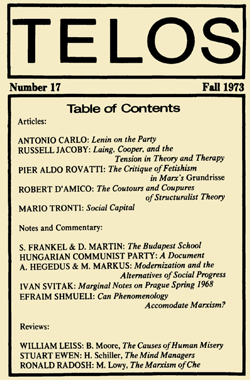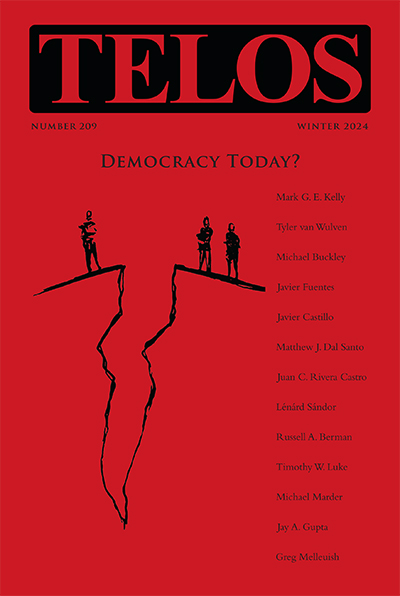As an occasional feature on TELOSscope, we highlight a past Telos article whose critical insights continue to illuminate our thinking and challenge our assumptions. Today, Frederick H. Pitts looks at Mario Tronti’s “Social Capital” in Telos 17 (Fall 1973). A second post on Tronti’s article will follow on Monday.

The labor movement is in crisis, with trade union density falling and its political parties increasingly discredited by their complicity with capitalist austerity programs. New fronts of anti-capitalist activity have been opened, away from the traditional structures of socialism and working-class organization, including the trade unions and the parties of labor. Mario Tronti’s article “Social Capital,” from 1973, presents a critique of trade unionism that possesses significant contemporary relevance in the light of these developments. Tronti presents trade unions as a central element in the capitalist regulation and organization of workers. The fatally compromised nature of trade unions under capital points the way toward different means of building struggles based not upon the maintenance of a status within society as “workers” but along alternative matrices of identity. An example is the Occupy movement’s clarion call of the 99% stacked against capital.
The changing complexion of the labor market has called into question the legitimacy of the labor movement as the chief conduit of struggle against capitalism. For example, an increasing amount of workers are employed in precarious conditions, and in part-time, temporary and fleeting forms of employment not immediately associated with the traditional base of trade union membership. In contrast to the earlier industrial proletariat, these precarious laborers do not fit so easily into the template of “workers” in possession of a clear occupational identity around which to articulate their political demands. The sense of one’s individual and collective position as a worker in the capitalist system is less profound among a new generation of employee. As Tronti’s critique of working-class organization suggests, the occupation of an identity as something other than a worker might present a means by which capitalism can be effectively challenged. Put simply, capitalism relies upon the maintenance of the class relation that pits capitalists on one side against workers on the other. Instead of mobilization on the basis of being one part of this relationship, perhaps what is needed is the escape from it entirely. In this post, I will discuss Tronti’s critique of trade unionism. In a second post, to appear on Monday, I will discuss the recommendations he makes for how we can move beyond these unsuccessful forms of organization with a creed of “anti-social” socialism.
For Tronti, social capital is the result of the “socialization” of capital beyond the merely economic and political and into the entire sphere of society and life itself. Only when this social quality has been achieved do we witness a “truly capitalist society,” in which society functions merely as a “moment of production.” This socialization of capital occurs through the “social organization of capitalist production” (105). This organization centers on the class relation between workers and capitalists. Reproduction is traditionally understood in the Marxist schema as the maintenance and renewal of the worker’s labor power so that they can continue to arrive at the factory gates fit and ready to work. Tronti, however, cites Marx’s further elaboration of this idea in the second volume of Capital. Reproduction does not only ensure the continuing supply of labor power, but also reproduces the “capitalist relation” that pits the working class on one side against the capitalist class on the other. Thus the aim is not merely to accumulate individual capital, as might be the case in a reproduction solely geared toward the material subsistence of labor power, but rather to generate social capital, of which the reproduction of classes is the central element. As Tronti puts it:
The individual reproduction of the single worker is no longer sufficient. A social reproduction of the collective workers becomes necessary, i.e. the brute survival of labor-power as such is no longer sufficient: what is needed is a process of accumulation of labor-power for social capital. Now, labor-power must reappear in that real natural form which is its social nature: variable capital must directly re-enter the process of capitalist production as working class. (113)
In Tronti’s account, the chief means by which this move is achieved is through the activity of trade unions. It is Tronti’s critique of trade unionism on these grounds that we will explore here. To the extent that capital has a “plan,” it regulates society so as to secure the function of the working class as such. By bestowing upon the workers a greater amount of power in capitalist system, their collective identity and effective operation as a specifically working class is ensured. In Tronti’s account, this is associated with the regulation of the working class in the structures of trade unionism. Tronti highlights the important of institutional structures and devices in securing the reproduction of the class relation. Rather than standing external or in opposition to the capitalist system, class struggle is in fact an integral element of its subsistence, of which trade unions represent a key component:
It is an objective requirement of capitalist production, on the level of social capital, to recuperate a real general terrain of the class-struggle. In fact, only through this recuperation can the class-struggle be consciously regulated and organized within the plan of capital. We have already seen how the labor struggle has always objectively functioned as a dynamic moment of capitalist development. Yet, it can be said that only on this level it can be rationally foreseen and utilized in the total process of production of social capital. Thus, the tension between capital and labor becomes a “legal institution of society,” and all the institutions which guarantee an orderly bourgeois development of particular labor claims can be legally recognized in their fill autonomy. The very organizations of workers acquire a decisive importance for the social interests of capital. There is a time in which modern capital cannot do without a modern union, in the factory, in society, and directly in the State. The political integration of the labor party within the absurd antediluvian forms of bourgeois Parliament, becomes itself a secondary moment of mediation, in order to arrive at the true organic integration of labor unions within the programmed development of capitalist society. (109)
The trade unions, and their parliamentary representation in the form of labor parties, function as the means by which capital ensures an orderly, organized working class. Unions bring coherence to the underlying anarchy of the working class, and “guarantee . . . that orderly pull toward . . . efficiency of the individual enterprises and of the entire system, which always comes from the trade-union activity of the workers.” In light of this organizing role, Tronti describes unions as “typical democratic institutions of capitalist planning.” The class struggle which is waged through industrial action and labor disputes is only that necessitated by the “immediate needs of production and reproduction of social capital,” a regulatory framework of social relations that is generalized by the process of socialization found in fully-developed capitalism (111). Antithetically, trade unions that profess to occupy a position “autonomous from the plan of capital” in actual fact achieve “the most perfect form of integration of the working class within capitalism.” The more they resist as workers, the more they persist as workers and nothing more. Thus, capital thrives on a class struggle that “reduces all those who work to workers.” Where the party of labor is introduced “as the transmission belt of the trade-union,” this integration reaches an even further stage of development (117).
What is indicated in the above is the total complicity and integration of trade unions within the framework of capitalist social relations, and their corresponding redundancy as a weapon against capitalism. They perform an essential reproductive responsibility of organizing and regulating workers as a class that only serves to sustain capitalist production. In my second post, on Monday, I will discuss the way in which Tronti represents the subsequent appearance of the class relation as a contradiction within capital, and the opportunities he describes for a struggle against capitalist waged from an alternative “anti-social” vantage point.
Read the full version of Mario Tronti’s “Social Capital” at the Telos Online website. If you are affiliated with an institution that is an online subscriber to Telos, you have free access to our complete online archive. If not, you can purchase 24-hour access to this and other Telos articles at a per-article rate. Follow the article link for more details.



